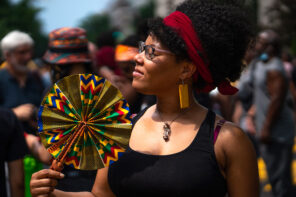As far as I can tell, the Christian liturgical calendar for October 13 is saint- and celebration-free at present. So, I’m going to be so bold as to suggest that we use the day to mark the ascendency of digital religious social media embodied in the live-streamed reality of the 33 Chilean miners being raised like so many Lazaruses from the tomb of a mine 2000 feet deep in the earth, where they’d been trapped for 69 days.
Oh, the event was clearly a broadcast media bonanza that allowed anchors across the spectrum to turn down the volume on a political season bewitched by lack of viewers and voter interest. But the real juice was online, where live-streaming service Ustream reported that more people viewed the rescue than had logged on to Michael Jackson’s funeral.
Other video streaming platforms were likewise inundated, with an overall increase in online traffic of 15 to 20 percent, according to Web monitoring services. And, what’s more, they did so over the course of a 23-hour drama that allowed the event to engage viewers across a world clock. As the final miners reached the surface, online viewership topped more than four million page views per minute. While World Cup soccer and Wimbledon matches broadcast online simultaneously last June had significantly more page views (10.4 million per minute) and the inauguration of Barack Obama in November 2008 had slightly more (4.3 million per minute), the rescue of the Chilean miners is the largest expressly spiritual, global, digital event.
In a world of spiritual ambiguity and religious indifference, the Copiapó miners’ ascents from the depths of the earth were nothing if not a participatory allegory of the human spirit challenged by the machinery of greed and raised up on the strength of a complex technology whose success seems to have been made possible only by the perfect balance of Digital Age ingenuity and old-fashioned faith. Wearing T-shirts with a verse from Psalm 95 on their backs—En su mano están las profundidades de la tierra; suyas son las alturas de los montes (In his hand are the depths of the Earth and the mountain peaks belong to him)—the miners’ bodies themselves enacted a liturgy of grace and thanksgiving that gathered millions throughout the day to live feeds from the mine shaft to computers, laptops, and smartphones around the world.
Millions, likewise, participated in the digital call-and-response of tweeted and retweeted updates from Chilean officials, onsite reporters, and friends and family members of the miners; along with prayers and encouragements from the millions watching the rescue. In addition, hundreds of Facebook groups sprung up as global digital sanctuaries for prayer and celebration throughout the day.
The relics the miners brought up with them (sealed in “Fénix 2,” the high-tech sarcophagus in which they surfaced, marked the digital-material liminality of the event) included: a bag of rocks from the Bolivian miner Mario Sepúlveda (miner #2) hewn from the earth that had contained them and, from Ariel Ticona (miner #32), the telephone receiver that allowed him to talk with his wife Elizabeth after she gave birth to their daughter, Esperanza (Hope)—an event he was able to watch by live video feed in the mine.
As we all watched the event unfold, Guardian UK writer Sam Wollaston compared it to an episode of the reality show Big Brother, which features a group of people under continuous video surveillance in a house cut off from the outside world. “But there is a difference,” Wollaston wrote. “You care. This is incredibly moving.” Of course he was right. It was, indeed, incredibly moving, and the comparison to reality TV makes a certain sense. But that’s not the half of it. The difference is much more than how the event felt to viewers individually, but rather how its presentation across the digital medial landscape enabled people to participate interactively in the spirituality it expressed.
Broadcast media generally depends on developing a vicarious identification with the characters they present, whether or not they are fictional. On a certain level, we can’t, in fact, tell the difference. As Indiana University of Pennsylvania professor Satoshi Kanazawa explains, “the human brain has difficulty distinguishing real friends and people [we] see on TV.” Our engagement with television characters and other celebrities is not, thus, necessarily shallow. It’s not real, of course, but our brains have not (yet) evolved to tell the difference between a real friend and television “friend.”
This has to do not only with the frequency with which we may watch television (or movies), but with the visual, aural, emotional, and social presentation of television characters. In evolutionary terms, the cues sent by our favorite Desperate Housewife are not any different from those sent by Sally-from-the-block. They’re just more interesting. Hence our urgency to ditch our flesh-and-blood friends or the Thursday soup social at church so we can get home to check in on the beleaguered castaways of Lost. Says Kanazawa, “Watching TV is our form of participating in civic groups because we do not really know that we are not participating in them.”
Reality television extends this phenomenon by bringing the identity cues of characters into closer alignment with the lives of ordinary viewers; a broadcast practice that I would argue has been necessitated by the ascendancy of participatory digital media. Digital social media, that is, has allowed us to employ technology in the service of real and meaningful engagements with others even when these engagements are not face-to-face. The 6,040 people in the Facebook group “Chilean Miners,” for instance (people from Germany, Ireland, Argentina, Canada, Ohio, Wyoming, and so on) were watching the live feed from the mine in their homes, workplaces, cafes and other distributed locales, but praying together for the miners, sharing news from their parts of the world, and, in general, witnessing and ministering to one another throughout the day.
It’s hard to tell where all this might lead. Predictably, alas, few religious leaders seemed to participate in the event. Father David Pauvif, a Roman Catholic priest who ministered to the miners and their families throughout the ordeal, was swarmed by reporters. He seemed to have had the grace and presence of mind to focus on the victimization of the miners that was muted by the celebration of their release and the ethical challenges that would be presented to the miners in the glare of their new celebrity.
Father Pauvif’s place was clearly on the ground in Copiapó, but one wonders how religious leaders might have exercised a more meaningful presence in the event as it unfolded and was engaged across a global digital landscape. As I scanned the emerging Facebook communities through the day and monitored Twitter feeds and news site comments, it was clear that few religious leaders were participating in what has to have been the most significant global spiritual conversation that has ever taken place on Earth.
As I write, religious leaders across the globe are preparing sermons for weekend services that will no doubt highlight the rescue. But, I have to wonder what impact their spiritual, biblical, ethical, and other insights might have brought to a worldwide spiritual experience that unfolded through the day on October 13—the Feast of Digital Ascension, if I had any say in such things—had more seen their ministries extending beyond the walls of churches, mosques, synagogues, and temples and into the waves of 1s and 0s that drew millions together in prayer.
That’s not religious television. It’s the new spiritual reality.




